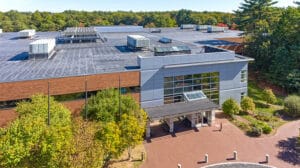
Suburban locations offer ample space for life science manufacturing. This month, German contract manufacturer Vibalogics leased 118,000 square feet at 1414 Massachusetts Ave. in Boxborough for its East Coast expansion. Photo courtesy of Colliers International
For years, Massachusetts has been renowned as the best place in the world for the life sciences. Its robust collection of leading colleges and universities, hospitals and medical centers, small and large biopharma companies and biotech startups collaborate like nowhere else to develop breakthrough therapies for patients.
This unique life sciences network and its continued growth has created a level of density that the Cambridge/Boston epicenter can no longer sustain. To ensure Massachusetts remains the number one life sciences cluster, policymakers and industry leaders across biopharma and real estate must continue to support the expanded development of mini-clusters throughout the state.
The growing need for strong life sciences mini-clusters is largely driven by space constraints and skyrocketing costs for biopharma companies. MassBio’s 2020 Industry Snapshot found that 16.5 million square feet of commercial lab space has been built in Massachusetts over the last 10 years, an increase of 91 percent – and it’s all full.
Only 0.8 percent of lab space is available in Boston, and zero lab space is reported vacant in East Cambridge, home of Kendall Square. To make matters worse, according to Cushman & Wakefield research average asking rents for commercial lab space in East Cambridge are approaching $97.97 per square foot, while in Boston, the average gross rent for commercial lab space has reached $108 per square foot square foot.
These factors, coupled with ill-maintained and unsustainable public transportation and infrastructure that forces longer and worse commutes into Cambridge and Boston, have led to more than tenants who had previously leased a total of 1.6 million square feet of space migrating out of East Cambridge over the last five years. This is a positive development for now and into the future as Cushman & Wakefield also found that the lab real estate inventory (roughly 20.6 million square feet currently) could double by 2024.
Connectivity Considerations Drive Decisions
Vital, successful life sciences clusters already exist in places like Worcester, Bedford, Burlington, Lexington, western Massachusetts and throughout the North and South Shores. It’s clear now that many life sciences startups and even larger companies are choosing to locate outside of Cambridge/Boston from the start to benefit from lower costs and proximity to where employees reside.
The suburbs also provide ample space to build manufacturing facilities, which will help spark a revival of commercialization in Massachusetts to sustain our legacy in the life sciences and promote job growth. These are, again, positive developments when considering the sustainability of the life sciences in Massachusetts.
However, the ultimate success of these mini-clusters is largely contingent on a reliable transportation system.
Businesses depend on connectivity between themselves and the Cambridge/Boston core and this will heavily rely on investments in Massachusetts’ decaying roads, bridges and public transit systems. Improvements will allow employees to readily travel into the Cambridge/Boston core for meetings, events and to tap into its resources while companies expand their footprint in the suburbs.
Though it’s possible the adoption of remote work amid the COVID-19 pandemic will alter the perception of the need to be in or near Cambridge/Boston and catalyze further migration, it is too soon to predict what long-term impact, if any, this will have.

Bob Coughlin
The development of mini-clusters is a logical extension of the growth we’ve seen in the Massachusetts cluster over the last 15 years. Cambridge and Boston remain the epicenter of our cluster, but it’s time to leverage that prominence and build stronger collaborations between the core and the rest of the state to establish state-wide dominance.
Traffic congestion will not subside after the pandemic, potentially threatening access to our greatest natural resource: talent. Therefore, we need to put companies and jobs where the people are to fortify recruitment and retainment and continue to attract the greatest minds in the life sciences.
As we look ahead to the next 5-10 years of life sciences innovation, the growth of mini-clusters across Massachusetts will be integral to the industry, state and patients.
Bob Coughlin is president and CEO of MassBio.




 |
| 

